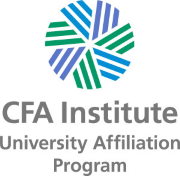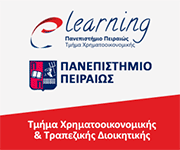Money and Banking
Course Name: Money and Banking
Teachers: Gikas Hardouvelis, Emmanouil Tsiritakis
School: Finance and Statistics
Department: Banking and Financial Management
Level: Undergraduate
Course ID: XΡΤΡΑ01 Semester: 4th
Course Type: Core Course
Prerequisites: –
Teaching and Exams Language: Greek
Course Availability to Erasmus Students: Yes
Course webpage: https://eclass.unipi.gr/courses/XTD103/
Specific Teaching Activities |
Weekly Teaching Hours |
Credit Units |
Lectures |
4 |
7.5 |
Course Content
This course presents and analyzes the structure and the operation of the financial system centered on the Central Bank and its handling of Monetary Policy and the Commercial Banking System and its role in financial intermediation and its ability to create money. The analysis is based on the determination of interest rates in the context of the supply and demand of loanable funds. The risk and maturity structure of interest rates is used to describe the relationship among short and long term interest rates and the effect of default and liquidity risk on the determination of nominal interest rates. Financial crises are analyzed as consequences of external or internal adverse shocks that fuel a sequence of adverse selection and moral hazard effects on the soundness of the banking system and the operation of the real economy. The second part of the course focuses on the risk management of commercial banks and the role of the banking system in the money multiplier. The open market operations of the Central Bank and its decisions to alter the discount rate or lending rate and the interest it pays on bank reserves as well as the required reserve ratio, is related to the workings of the interbank lending process and the equilibrium interbank rate. The architecture of the European Central Banking system is presented and explained with the interpretation of recent events which rocked the system down to its foundations.
CONTENTS
1. The meaning of money
1.1 Definition and functions of money
1.2 Payment Systems
2. The Financial System
2.1 Financial Markets
2.2 Financial Institutions
2.3 Financial Instruments
3. Interest rates
3.1 Loanable funds theory
3.2 Liquidity preference Theory
4. The Structure of Interest Rates
4.1 Risk structure of interest rates
4.2 The Yield Curve
5. Asymmetric Information and Financial Intermediation
5.1 Adverse selection and moral hazard
5.2 Mitigation of the asymmetric information problems
6. Financial Crises
7. Banking and the management of financial institutions
7.1 ALM
7.2 Bank risks
8. Monetary Policy the Banking System and the Supply of Money
8.1 Money creation in the Banking System and the money multiplier
8.2 Instruments of Monetary Policy
8.3 The Interbank Market of Reserves
9. The European System of Central Banks and the contact of Monetary Policy
9.1 Policy Priorities
9.2 ESM
Teaching Results
The course:
• presents and analyzes the role of money in the economy
• presents and analyzes the role financial markets and financial intermediation in the flow of funds from lenders-savers to the borrowers-spenders in the economy
• analyzes the determination of interest rate in the money and capital markets
• presents and analyzes the role of financial institutions such as commercial and investment banks in the financial intermediation process
• analyzes the role of the banking system in the money supply process
• presents and analyzes the basic tools of monetary policy
• presents and analyzes the functioning of the interbank market
• presents and analyzes the role of the Central Bank in the Economy
After the completion of this course students will be able to:
• understand the relation between interest rate determination and the business cycle
• understand the shape of the yield curve and the information emanating from it
• understand the way financial intermediation mitigates the adverse selection and moral hazard problems
• understand the root causes and the evolution of financial crises as well as their impact on the real economy
• understand the monetary policy effects on interest rates inflation and unemployment
Skills
• Retrieve, analyze and synthesize data and information related to the Monetary Policy decisions
• Understanding the functioning of financial and credit markets
• Identify and appreciate the impact of financial shocks on the Real Economy
• Synthesize the interaction of Central Banks Commercial Banks and the Real Economy
Teaching and Learning Methods - Evaluation
Lecture: In Class, Interactive
Use of Information and Communication Technologies: Powerpoint Slides
Teaching Analysis:
Activity |
Semester Workload |
Lectures |
52 |
Home, Library and Lab |
135.5 |
Total |
187.5 |
Student Evaluation:
Written Final Exam
Recommended Bibliography
Χρήμα και Τράπεζες, Α. Νούλα, 2015.




